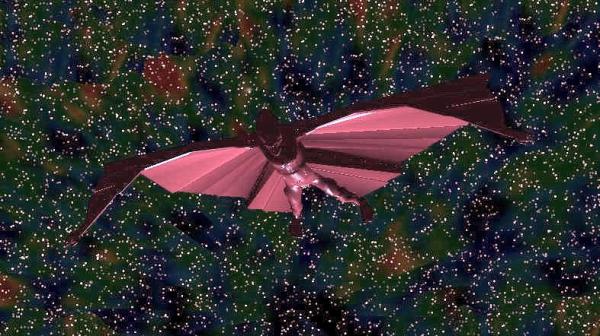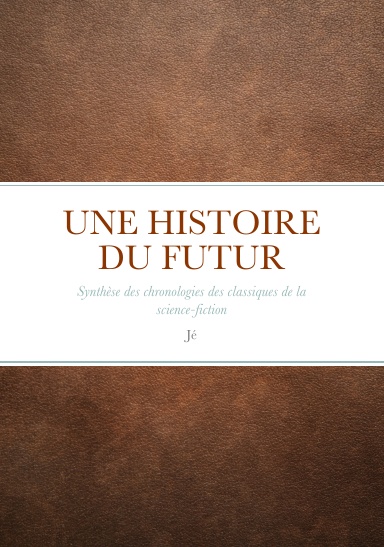
Image from Steve Bowers
| |
| A Sailor collecting light energy; this false colour image includes some of the extra wavelengths that a Sailor can detect, including the Cosmic Microwave Background | |
The Sailors are a relatively small clade that can be found in numerous inhabited systems. Their earliest accounts suggest that they were the creations of a Power who was interested in exploring the extremes of biont adaptation. The Sailors are tweaks who have been adapted to long term survival in 0-g vacuum environments. As long as they have regular access to food, water, and sunlight, they can survive indefinitely in the vacuum of space. The extensible solar collecting membranes that fan out from their back allow them to live comfortably anywhere from 0.5 to 5.5 AUs from a G2 star. When fully extended, the membranes look somewhat like great black moth wings. The Sailors are completely adapted to life in space and can eat, excrete and even mate in vacuum. The only times they must enter a pressurized environment is to give birth or to undergo certain medical procedures. In all such cases, a low- pressure inert gas provides sufficient protection.
Unlike the various other vacuum adapted bionts, the Sailors of the Ebon Sea are also equipped with a natural plasma sail. Using biologically generated electricity and small quantities of hydrogen gas, these bionts can create vast solar sails made of plasma, allowing them to reach anywhere in the habitable portions of a star system within a few months. A few lucky veteran space travelers have looked out the window of their cabin and seen the sight of a Sailor cruising by with its plasma sail gently illuminated by internal fluorescence.
Biology
Physically, the Sailors are humanoids that range between 1.8 and 2.4 meters tall. They have slender, somewhat attenuated limbs, large barrel-like chests, and a noticeable hump-like bulge on their backs. Their skin is hairless and as smooth and thick as a terrestrial dolphins'. Their eyes are quite large, and like many other vacuum-adapted humanoids are capable of interpreting a frequency range from the cosmic microwave background (useful for orientation) to the far ultraviolet, using the Extended Colour Convention. They possess baseline equivalent senses of touch, taste, hearing, and smell, although the later two can only be used when they are in an atmosphere.In addition, they can communicate using both radio waves and UV lasers. Their radio communications are general broadcasts that they can receive at a range of up to 20 million km (less in systems with high levels of radio noise). Radio communication is equivalent to baseline speech, and can also be used to communicate with the radios used on most spacecraft. In contrast, their laser communications have a range of only 100 km, but are a high bandwidth method of communication that essentially allows the participants to send and receive thoughts, images, and detailed sensory information. Because the Sailors possess only two laser emitters (located on either side of their foreheads), they can only communicate in this fashion with no more than two others of their kind. One consequence of the neural hardwiring associated with laser communications is that sane Sailors cannot deliberately lie when using laser communication.
Their solar-collection membranes are extremely thin and can be completely retracted, allowing them to wear ordinary space suits or other clothing. The hump on their back becomes somewhat wider when these membranes are retracted. Each of these two membranes can be extended to cover up to 30 m2. Also, while they possess fully prehensile feet, they are able to live and walk normally in gravities up to 12 m/sec2. However, they find gravities of 5 m/sec2 or less to be far more comfortable.
Psychology
While Sailors exhibit the same social and cultural diversity found among most humanoids, Sailor societies typically have several features in common. While they are physically somewhat solitary Sailors are extremely gregarious with respect to communication. Many Sailors talk to nearby fellows on a nearly constant basis. However, this applies only to radio communication. Only friends, lovers, or family members regularly communicate using the more intimate laser mode. However, brief bouts of such communication are exchanged between Sailor who wish to ensure both honesty and clear communication.Because of the depth of their laser communications, serious disagreements and misunderstandings between Sailors are far less frequent than among baselines. Many Sailors have difficulty trusting sapients who they cannot communicate with in this fashion. As a result, most bionts and aioids who work with Sailors on a regular basis are altered to be able to utilize this communication mode. While Sailors can be formidable warriors, in almost all cases their conflicts are outside their clade.
While there are occasional exceptions, the vast majority of Sailors not only prefer living in open space or among asteroid belts, they find the experience of being in open space to be deeply spiritual. There seems to be a biological basis for such feelings, leading many Sailors to believe that their creator designed them to find spiritual truths in this vast and empty environment.
Society
The Sailors of the Ebon Sea generally live on asteroids or small moons. They usually prefer to reside on bodies that they can leave without external aid, restricting them to bodies less than 20 kilometers in diameter. They build hospitals and residences on such locations. While Sailors can subsist on ice and heavily modified vacuum adapted lichens, most prefer a more varied diet. As a result, their inhabited asteroids all contain pressurized locations dedicated to food production and preparation. The Sailors have developed a number of surprisingly tasty vacuum-proof concentrates made from conventional human foodstuffs. Although Sailors tend to be nomadic, most prefer to have a home base that they return to periodically.In more backward systems where all industry is not performed by advanced nanotechnology, Sailors frequently work in 0-g and vacuum industries, asteroid surveying and mining. Others act as discrete couriers or smugglers between space habitats, or as crew members on all manner of spaceships. A few Sailors enjoy visiting habitable planets and mingling with the great masses of humanity, but most prefer stays on orbitals and space colonies, since they are not as far from the beloved emptiness of space.
In the vast majority of cases, Sailor societies operate as either free- form anarchies or direct democracies. However, in some backward systems franchise and rights are only granted to other Sailors. In some systems Sailors enslave non-space-adapted bionts to work as servants and technicians on their asteroid residences. Unable to leave without aid, these slaves have little choice but to obey their masters. In a few primitive systems, the Sailors have even enslaved entire space colonies and regularly prey upon low-tech cargo ships. While such practices are fortunately rare, the Sailors have an exceedingly negative reputation in some systems.
Spirituality
The most universal feature of Sailor psychology is their love of being in open space. When not occupied with other tasks, many Sailors will spend many hours meditating in vacuum. Such periods of meditation often substitute for the sleep that many other clades of tweaks and near-baselines require. Sailor often have trouble describing this experience to outsiders, but it seems to involve a feeling of oneness with the universe and a sense that the universe itself is a vast conscious entity. Some Sailors also claim that stars are sapient beings and a few believe that they have actually received messages from these stars. The more devote Sailors often channel these religious feelings into efforts that range from creating religious treatises to engaging in advanced astronomy or studying the nature of the structure of space.Source : http://www.orionsarm.com/eg-article/47f597011eb3c


















4 commentaires:
Extended Color Convention
Ever since the time of the first true body modifications, there were attempts to modify and extend the human eyesight. At first, these were little more than night vision ability implanted into the eyes. Within a century or so, they advanced enough to detect EM radiation from ER to gamma rays at least. Genetic modifications advanced to a similar level, although lagging a couple of decades behind.
When an attempt was made, however, to use such modifications not just for military and research purposes, but put them on the market, it turned out they were to the public what the first personal computers were – useful for special purposes, but too lifeless and inconvenient for daily use, and useless for recreation. People wanted to really perceive the radiation outside the baseline perception. The modifications only provided raw data, but people wanted colors. Naturally, while the technology for detecting and separating the spectrum was rather simple, other problems presented themselves.
The baseline human eye can see colors in a narrow band with a 100% difference between the lower and the higher threshold. Within this narrow band, the eye perceives different lengths differently enough to usually require six separate names for the colors (not counting the names for the darker and lighter hues like pink and brown and numerous name for hues like magenta and lavender). Extrapolating, a being with an order of magnitude difference between the thresholds would require 20 names.
The truth wasn’t that far out. And considering five to ten orders of magnitude perception is far from uncommon in the Terragen Sphere – in fact, it was quite possible enough even in the early Interplanetary Years from a hardware point of view – it created some problems.
An ability to separate wavelengths was a strain on both the eye and the visual cortex. Perception time increased well above the normal 1/15 of second. Of course, that one was easy enough to fix with modifications –considering every single 20th-21st century movie has to be remade into at least 100 fps when watched by a person with any significant modifications, that part was trivial.
A bigger problem was brain perception. While baseline people might sometimes dream or imagine a color they can’t see, a hundred distinct colors is difficult for a brain to process. People normally refused to use the simplest solution – adjusting the perception to extend the color bands. A few nearbaselines still exist practicing that solution – the so called Adieans – but their numbers are measured in single digit millions at best. For most people, other ways had to be sought. While, eventually, both a hardware upgrade and a genetic modification method were found, this, as usual, led to additional problems.
First, the imperfect modifications led to the colors perceived differently by different people. As a result, no names for the new colors could be agreed upon, nor was it possible to directly exchange memories and experiences in any meaningful manner.
The second problem, of course, was aesthetics. The same type of lighting could look either intolerable or heavenly to different people. A more serious (though rare) problem were cases like that of Diralon Klent, “The Seeing Blind”, who required his eyes to be replaced every few weeks, in addition to constant anti-radiation therapy, due to being addicted to a certain combination of gamma ray frequencies and intensities.
While different people preferring different colors is far from undesirable, the combined difficulties were becoming bothersome, and were sometimes causing severe social tension. Of course, the problem, while by no means a simple one, wasn’t that hard either. Less serious attempts started as soon as the modifications began – in fact, some philosophical reflections on the subject show up in even older sources. The first serious attempt at establishing a complete system dates to approximately 300 a.t. Within three centuries, a more or less workable pattern was ready. Additional polishing continued until approximately 2300 a.t., when a group of lvl 3 transapients brought the entire spectrum to a complete, organized system of modifications and terminology, as well as establishing a matching stable genetic modification. The system ey created was organized, clear, and aesthetically pleasing enough for it to be all but universally accepted, at least among homo sapiens descendants, and soon became known throughout the Terragen Sphere as The Extended Color Convention.
Eventually, the system fractured into variations almost as numerous as the variations among Terragen sophonts. However, just like a rather large percentage of these use a form close in shape to that of a basic human’s, so can the visual perception of a similar or even larger percentage be identified as close variations of the ECC, close enough for the word “neas” and “nede” (the colors immediately above and below baseline perception, respectively) to be as universally understandable as “thumb”.
The percentages of the ECC users, of course, are lower among provolves originating from differently perceiving subsophonts, and some of them require different systems. Additionally, a number of bionts tend to temporarily modify themselves with alternate color perception for the sake of experience or as a fashion (It is rare for a month to pass without some libertarian transapient releasing a new system for these purposes, although it seems unlikely for the ECC to be replaced in the foreseeable future). Ais normally accept the same systems when they are relevant, while higher toposophics use their own systems, incomprehensible to others.
It is agreed, for example, that xit is a color corresponding roughly to 260- 295 micron wavelength. It is agreed, likewise, that sten is a color corresponding to 52-60 nm. Likewise, most terragens agree that bright sten and dark xit clash horribly unless you add a bit of klis (1.9-2.25 micron) or green. Of course, this may change with fashion or individual upbringing (around 8200, for example, there was a trend through much of the Terragen Sphere to wear sabum-krip-blue clothes, something considered absolutely horrible in the 11th millennium).
Aioid
Aioids are nonbiological sentient beings who are not tied to a particular body (like vecs, neumanns, and sentient structures or sentient ships), are not descended from or simulations of embodied creatures (like uploads, virtuals, and copies), and are not alifes. Since the definition of an individual is even more fluid than for those who inhabit discrete bodies, and since the distinctions between active, inactive, and occasionally active individuals is also fluid, it is difficult to count them accurately, but depending on definitions the number of these "pure" ai beings, the turingrade near-sophont and sophont agents, companions, expert systems and less definable beings who dwell in the Known Net or in habitats, appliances, and localnets, easily approaches twenty thousand trillion (500 trillion as ship pilots alone); many times more again are subsophonts.
Aioids with less native intelligence than a human being are generally known a sub-turing entities; this means they are not capable of passing the so-called Turing Test. Those aioids which are roughly equivalent to a baseline human in intelligence level are often referred to as turingrade; most, if not all, turingrade machines can pass the Turing Test (depending on how it is administered). Modosophont aioids who are more intelligent than baseline humans but less than transapient are generally known as superturings; these superbright minds are often used even today for many complex tasks.
AIs who have passed the First Singularity are known as Hyperturings; these transapient AIs are not regarded as aioids, since that term is reserved for modosophont ais only.
These terms should not be confused with the term used in information technology for an idealised computer, a Turing Machine.
Turing Test
Turing's proposed test for whether a machine is conscious (or intelligent, or aware): the subject communicates via text with the machine and with a hidden human. If the subject cannot tell which of their partners in the dialog is the human, then the computer is conscious (i.e. is an AI). Turing did not specify many key details, such as the duration of the interrogation and the sophistication of the human judge and foils. By the middle Information Age, computer AIs were regularly passing the test, although its validity remained a point of controversy and philosophical debate for some decades more.
Enregistrer un commentaire